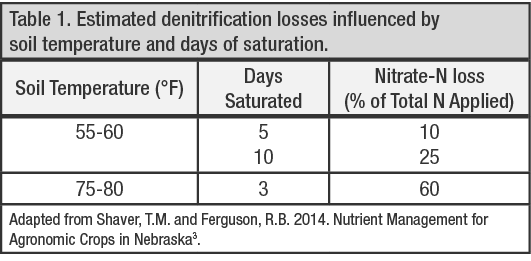When soils become saturated from heavy rainfall, loss of nitrogen (N) becomes a major concern.
After soils are saturated, the two processes that can reduce the amount of available N are denitrification (microbial conversion of nitrate to nitrogen gases) and leaching.
Estimating N loss is not an exact science; however, some guidelines exist that can help with N assessment.

Leaching is more of a concern with soils that allow rapid downward movement of water such as sandy soils, well drained soils, and/or soils with improved drainage. Ammonium nitrate and urea ammonium nitrate (UAN) solutions are more susceptible to leaching than anhydrous ammonia, with differences due to the rate of conversion to nitrate, as well as the N compound applied in the fertilizer products. Once fertilizer N is converted to nitrate, there will be no difference in the behavior of N in the soil profile between any sources of fertilizer N.

1Sawyer, J. 1999. Estimating nitrogen losses. Integrated Crop Management-482(14). June 14, 1999.
2Nielsen, R.L. 2006. N loss mechanisms and nitrogen use efficiency. Purdue Nitrogen Management Workshops, pg 1.
3Shaver, T.M. and Ferguson, R.B. 2014. Part 1, Fertility Principles. Nutrient Management for Agronomic Crops in Nebraska. University of Nebraska. http://www.ianrpubs.unl.edu
4Hoeft, R. Predicting and measuring nitrogen loss. The Bulletin. No. 10, Article 8, May 28, 2004.
5Camberato, J. and Brad, J. 2006. Nitrate-nitrogen: here today gone tomorrow? Purdue University. https://www.agry.purdue.edu
6Alley, M.M., Martz, M.E., Davis, P.H., and Hammons, J.L. 2009. Nitrogen and phosphorus fertilization of corn. Virginia Cooperative Extension.
Laboski, C. 2011. Assessing nitrogen losses after heavy rains. University of Wisconsin Extension. http://www.uwex.edu
Torbert, H.A., Hoeft, R.G., Vanden Heuvel, R.M., Mulvaney, R.L., and Hollinger, S.E. 1993. Short-term excess water impact on corn yield and nitrogen recovery. Journal of Production Agriculture 6:337-344.
4010_S2
RELATED ARTICLES
Loss of Nitrogen
Denitrification occurs under anaerobic (lack of soil oxygen) soil conditions. Nitrogen in the ammonium-N form (NH4+) is not subject to denitrification or leaching. Nitrogen loss can occur rapidly if soils are saturated or flooded, soil temperatures are >50° F, or nitrate-N (NO3-) is present. Studies conducted in Illinois showed that up to 5% nitrate-N loss through denitrification occurred each day soils were saturated.1 In these studies, an all-nitrate fertilizer was applied when corn was in the V1 to V3 growth stage. Urea converts to nitrate quicker than anhydrous ammonia; approximately 2 weeks and 4 weeks, respectively.2 University of Nebraska data (Table 1) demonstrates the potential nitrate-N loss for every day of saturation at various temperatures. While the process of denitrification is ultimately dependent on saturated soils, the potential for N loss due to denitrification also increases rapidly as soil temperature increases. In soils where saturation or ponding typically occurs, special consideration should be made to either not apply N until the risk of soil saturation decreases or retain N applications in the NH4+ form until the crop is able to utilize NO3-.
Is Supplemental Nitrogen Necessary?
Applications of supplemental N may be warranted if sufficient loss has occurred. The amount of N loss is hard to quantify as it depends on several factors, including soil type/structure, soil temperature, form of N, and days of saturation. One method to determine if supplemental N is required is the pre-sidedress nitrogen test (PSNT). PSNT soil samples should be collected to a depth of 1 foot when corn is between 6 and 12 inches tall. The accuracy of the test is highly dependent upon the sampling and handling procedures. Contact your lab for proper sampling and handling techniques. Test results of over 25 ppm can indicate that no additional N will be needed for the growing season.4 Test results less than 25 ppm can indicate you may get a positive yield response from sidedress N. In theory, the lower the test level the more N you will need to apply. Refer to local university guidelines or consult an agronomist for the amount of additional N to apply if PSNT results are under 25 ppm.
Estimating N loss
Calculate N present as nitrate: (N applied multiplied by % in nitrate form).
Calculate N denitrified: (lb of nitrate/acre from Step 1 multiplied by % denitrified from Table 1 above).
Note that the conversion to nitrate occurs almost immediately with N applied as urea. With 28% or 32% UAN, half of the N is in the urea form, 25% is found as ammonium, and the remaining 25% as nitrate. The nitrate is already subject to loss, and the other fractions are readily converted. Conversion of N applied as anhydrous ammonia is delayed 10 to 14 days following application, regardless of any stabilizer added. Soil temperature has a large influence on the conversion of ammonium to nitrate. It takes approximately 2 weeks for complete conversion at 60° F and 1 week is needed at 70° F.5
Nitrogen Management
Nitrogen should be applied via side-dressing if a significant amount of N has been lost through denitrification or leaching. UAN liquid solutions can be applied as a band on the surface with drop nozzles, even on fairly large corn. To help minimize volatilization and maximize effectiveness, rainfall or irrigation is needed to move UAN and urea into the soil. Up to 30% of the urea could be lost due to volatilization if no rainfall occurs within two weeks and temperatures are warm.6
To help optimize yield potential in corn, adequate N is critical. Purdue University provides general recommendations by N form, timing of N application prior to excessive rain, and soil type (Table 2). Assessing N loss and requirements is not an exact science, but it can help provide estimates that impact your bottom line.
